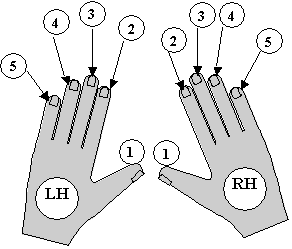Piano Fingering for the Very Young

Piano fingering for the very young is a matter of common sense. The younger the child, the less digital control they have. My message to you is that you must adopt an attitude of patience because young kids are barely aware they have five different fingers!
This is why, with toddlers and preschool kids, I allow them to use their dominant index finger because that is what they will instinctively offer you. Thus, until the child is capable of more, accept the uni-finger method. Move on to teach other things until they are ready. Choose your battles.
Fingering Basics
Fingering, in the classic sense, is the art of assigning the fingers to specific keys. This is in order to make difficult groups of notes easier to play. But younger kids need first to be made aware that they even have ten fingers, of five different types (thumb, index, middle, ring, pinkie.) They will have played “This Little Piggie,” but piano fingering is infinitely more complicated. Instead of insisting on fingering, you would do better to explore what the child actually knows about their fingers, both singly and in groups.
Piano Is Easy
How To Get The Fingers In A Row
Here are steps to make younger kids more aware of their differing fingers. I can almost guarantee you they have never thought about any of this. Since they are offering you the index finger, start suggesting they use BOTH index fingers. Let them choose when to use them.
Without them knowing it, they are now exercising both hemispheres of their brain. This is because the left index finger is controlled by the right brain, and the right index finger is controlled by the left brain.
Next, point out that there is a finger right next to the index, the third finger, which might be very useful. Suddenly you’ll find the child fascinated with using the two fingers (second and third) as a pair. Most likely they will make a childish game of walking up the piano with those two fingers acting like two legs. The fourth and fifth fingers on a child’s hand are almost useless at first, so introduce the thumb now.
Kids Aren’t Aware Of Their Fingers
Hold up your hand and point out that the thumb is half as long as any other finger, and yet is twice as strong. Kids avoid the thumb because it is shorter. They prefer the longer fingers that reach the keys more easily (2,3,4 and 5.) Your first major objective is to get the child to use the first three fingers, thumb, index and third, as a group. I made up a game called “threesies” to help develop this skill.
Threesies Fingering Game
| 1 2 3 | 2 3 4 | 3 4 5 | 4 5 6 | 5 6 7 | 6 7 8 |
Mary Had A Little Lamb
(played with thumb on 1, index on 2, third on 3.)
| 3 2 1 2 | 3 3 3 * | 2 2 2 * | 3 5 5 * |
These groups of three notes (123,234, etc.) are played with the same finger group: thumb, index, and third. From here, it is an easy jump to get the child to use all five fingers, since they have already established strength with the first three (thumb, index and third.)
Next, try "Mary Had A Little Lamb" and play it using the first three fingers. It is the only song that fits these three fingers, but it is relatively easy to do, and introduces younger kids to fingering in a very gentle way.
REFERENCES
Fingering
What Is Fingering?
Piano Fingering Diagram
One-Finger Johnny
Developing Children’s Piano Finger Instincts
Exploring Fingering
Kid’s Finger Olympics
Finger Organization Games
When Is Fingering Necessary?
Piano Fingering for Kids
Children’s Piano Fingering Strategy
Piano Fingering for Preschool Kids
Kid’s Piano Fingering 101
Make Piano Fingering Logical
Piano Fingering for the Very Young
Piano Finger Numbers Worksheet
Fingering and Familiar Songs




